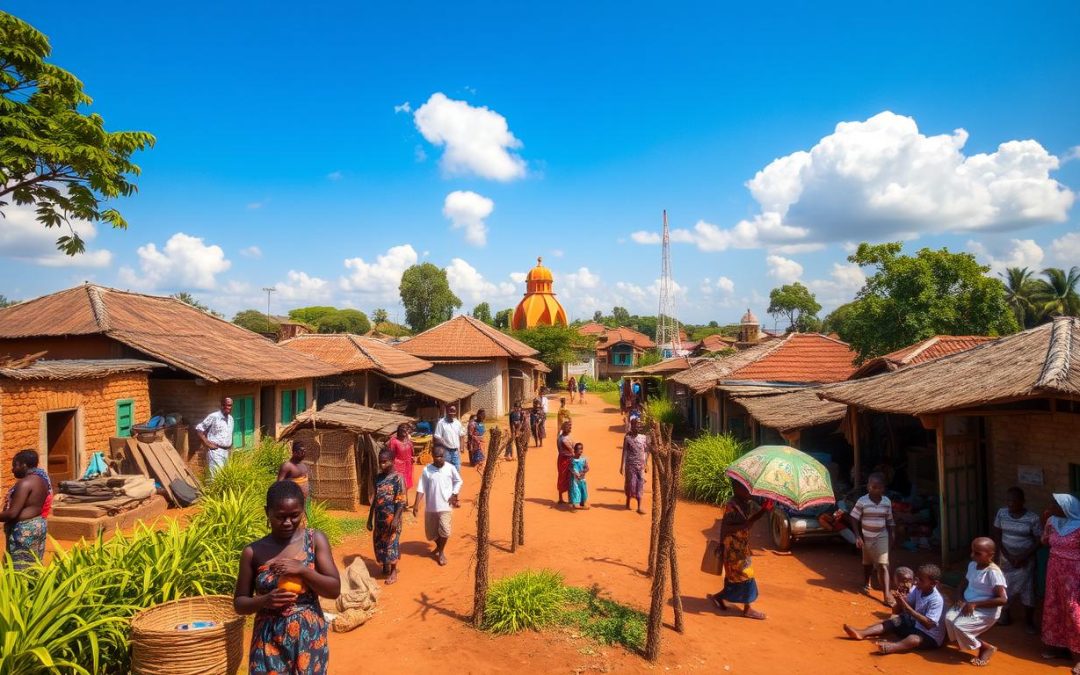Have you ever wondered how a single country can speak dozens of languages and still feel united? In Benin, this puzzle is solved with amazing complexity and richness.
Benin is a fascinating place where French is the official language, but indigenous tongues like Fon are also common. With 55 languages spoken, Benin shows incredible linguistic diversity. This diversity reflects its rich cultural heritage.
French is key in government, education, and official talks, spoken by about 3.8 million people. But, indigenous languages like Fon, used by 24% of the population, are vital for local talks and keeping culture alive.
Exploring Benin’s language scene shows a complex system where official and traditional languages live together. This mix shapes the country’s identity in a unique way.
Key Takeaways
- Benin has 55 total languages, with 50 being indigenous
- French is the official language, spoken by 33.68% of the population
- Fon is the most widely spoken indigenous language
- Language use varies significantly between urban and rural areas
- The linguistic landscape reflects historical colonial influences
Understanding Benin’s Linguistic Diversity
Benin is a place of amazing language variety, with over 50 languages spoken. These languages show the country’s rich culture. They tell the story of Benin’s many ethnic groups.
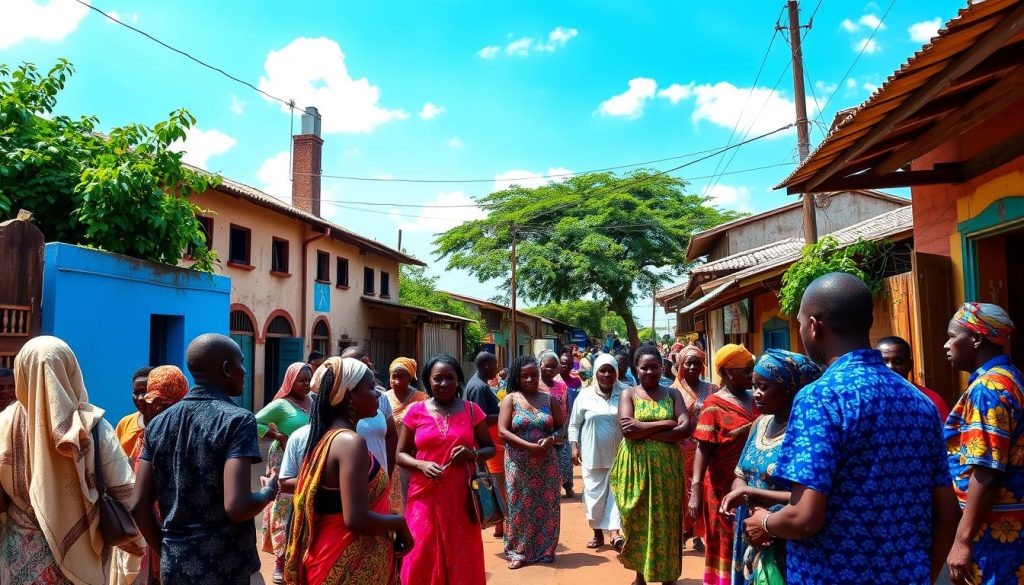
Language Distribution Overview
The languages in Benin vary by region. In the south, you’ll find:
- Fon: The language of the largest ethnic group
- Yoruba: Predominantly spoken near the Nigerian border
- French: Used in official and administrative contexts
Historical Language Evolution
Benin’s language history is complex. The Yoruba language grew through trade and cultural exchanges. Meanwhile, Bariba developed its own unique traits in the north.
“Languages are the roadmaps of a culture. They tell you where a people come from and where they are going.” – Unknown
Current Language Demographics
| Language | Region | Estimated Speakers |
|---|---|---|
| Yoruba | Western Benin | 1.5 million |
| Bariba | Northern Benin | 800,000 |
| Dendi | Northern Regions | 400,000 |
| French | Nationwide | Official Language |
Exploring Benin’s languages shows a lively scene. Languages here do more than just communicate. They also keep cultural identities alive. Each language has its own story, linking communities in this lively West African nation.
French as the Official Language of Benin
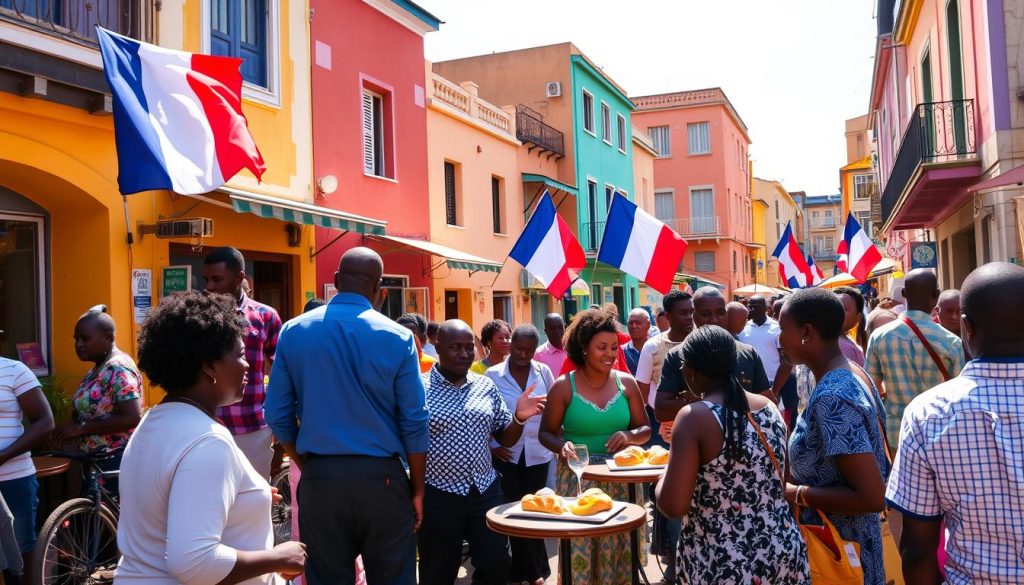
Exploring Benin’s language scene, French is the standout official language. It has deep roots in the country’s colonial past. Introduced by the French, it now connects different ethnic groups across the nation.
French is more than a government language in Benin. It’s a key language for communication among many ethnic groups. About 3.8 million people speak French out of Benin’s 13 million people.
“Language is the roadmap of a culture. It tells you where its people come from and where they are going.” – Rita Mae Brown
The role of French in Benin is vast:
- Government communications
- Educational instruction
- Media broadcasting
- Professional environments
Benin has its own French variety, called français d’Afrique. This unique dialect shows the country’s cultural richness while keeping standard French’s core.
Understanding Benin’s language shows French’s key role in unity. It helps unite the country, beyond ethnic differences, with a common language.
Benin: Official and Widely Spoken Languages
Benin’s language scene is rich and varied, showing the country’s deep cultural roots. With over 50 different language groups, it’s a place where communication is more than just words.
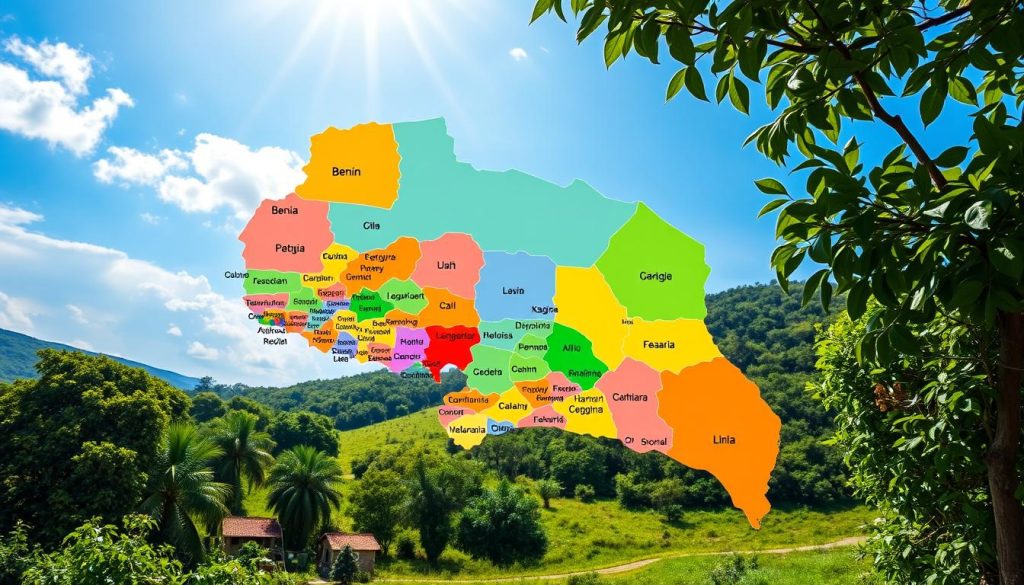
Statistical Language Distribution
In Benin, some languages stand out more than others. Fon is the most common, spoken by about 50% of people. It’s especially popular in the south and center.
- Total languages in Benin: 55
- Indigenous languages: 50
- Official language: French
Urban vs Rural Language Usage
In Benin, language use changes a lot between cities and countryside. French is the official tongue, but local languages like Fon and Yoruba hold cultural significance. Cities tend to favor French, while rural areas stick to their native tongues.
Language Policy and Planning
Benin aims to keep its languages diverse while uniting the nation. The government values Fon and Yoruba for their role in keeping cultural identity alive.
| Language | Percentage of Speakers | Primary Regions |
|---|---|---|
| Fon | 50% | South and Central Benin |
| Yoruba | 12% | Western Benin |
| French | Official Language | Nationwide |
“Language is the road map of a culture. It tells you where its people come from and where they are going.” – Rita Mae Brown
Exploring Benin’s languages shows a nation that honors its past and meets today’s communication needs.
Major Indigenous Languages in Southern Benin
Southern Benin is home to a rich mix of languages, with Fon and Yoruba leading the way. These languages show the area’s cultural variety and deep history.
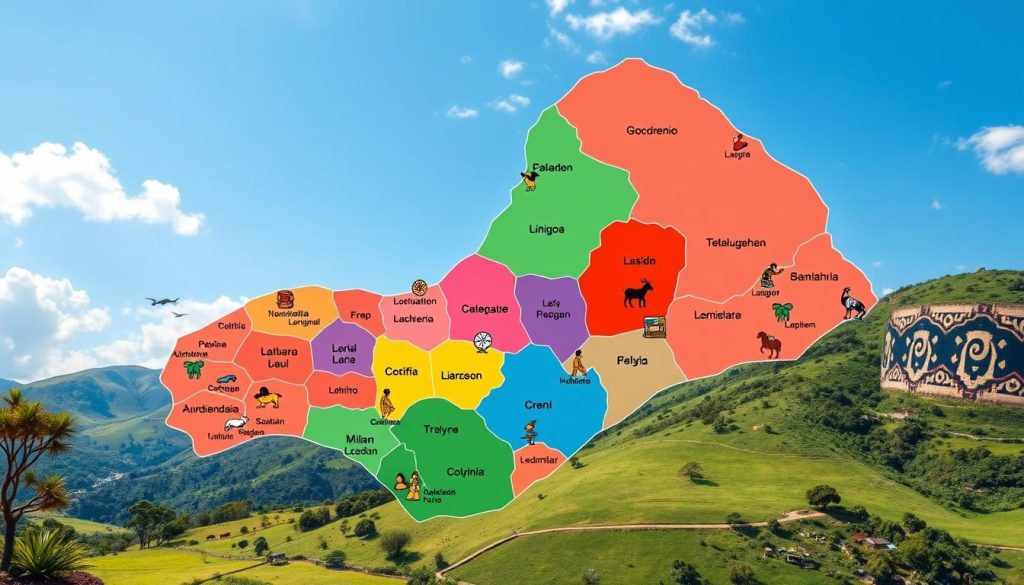
The Fon language is widely spoken in southern and central Benin. Yoruba speakers also play a big role, enriching the area’s language scene.
“Language is the roadmap of a culture. It tells you where its people come from and where they are going.” – Rita Mae Brown
Key Language Distribution
- Fon: Primary language in southern Benin
- Yoruba: Significant presence in southwestern regions
- Gun: Important indigenous language in southern areas
- Aja: Spoken in specific southern communities
| Language | Primary Regions | Estimated Speakers |
|---|---|---|
| Fon | Southern and Central Benin | 40-45% of population |
| Yoruba | Southwestern Regions | 12-15% of population |
| Gun | Coastal Southern Areas | 8-10% of population |
These languages are more than just ways to talk. They hold centuries of stories, traditions, and social bonds. Fon and Yoruba keep the spirit of southern Benin alive.
Even though French is the official language, Fon and Yoruba are still key in everyday life. They show how local languages can survive and thrive, even with modern changes.
Northern Benin’s Language Landscape
The northern parts of Benin are a colorful mix of languages. This mix creates a rich cultural scene. Exploring this area shows us how different groups talk to each other.
Northern Benin is home to many language groups. Each group has its own way of communicating.
Bariba Language Communities
Bariba is a key language in northern Benin. It’s mainly spoken in the Borgou Department. Cities like Parakou and N’Dali have big Bariba-speaking populations. About 500,000 people use Bariba to talk.
- Primary geographical concentration: Borgou Department
- Estimated speakers: Around 500,000
- Cultural significance: Primary language of local ethnic groups
Dendi Speaking Regions
Dendi is also important in northern Benin, especially in the Alibori Department. It was once a key trade language. People in areas near Niger and Nigeria speak Dendi.
Other Notable Northern Languages
There are more languages in northern Benin besides Bariba and Dendi. Yoa is another important language in the area.
| Language | Estimated Speakers | Primary Regions |
|---|---|---|
| Bariba | 500,000 | Borgou Department |
| Dendi | 250,000 | Alibori Department |
| Yoa | 100,000 | Northern Border Regions |
Learning about these languages helps us see how people in northern Benin interact and connect.
Endangered and Vulnerable Languages
In Benin, many indigenous languages are at risk. The Ditammari and Nateni languages show the diversity that could disappear.
UNESCO’s work on endangered languages shows how critical the situation is. They classify languages from Vulnerable to Critically Endangered. This highlights the need for urgent action to save them.
“Language is the roadmap of a culture. It tells you where its people come from and where they are going.” – Rita Mae Brown
- Aguna language: Currently has only 3,470 native speakers worldwide
- Anii language: Estimated between 25,000 to 50,000 speakers
- Tchumbuli language: Classified as Critically Endangered
The Ditammari language in Benin faces big challenges. Urbanization, globalization, and changes in education policies harm these languages.
Keeping Nateni and other endangered languages alive is more than just documenting them. It’s about protecting cultural heritage and the variety of human communication.
Researchers and local communities are working hard. They’re creating documentation projects and revitalization efforts. This ensures future generations can connect with their linguistic heritage.
Foreign Language Influence and Education
Benin’s language scene is changing fast with more global ties and job chances. Foreign tongues are key in shaping education and work life.
English Language Growth
English is becoming more important in Benin, thanks to its strategic location and economic ties. Being close to Nigeria, where English is widely spoken, boosts the need for English skills in many fields.
- Increased trade opportunities with Nigeria
- Growing international business connections
- Enhanced global communication capabilities
Other Foreign Languages in Benin
Even as English grows, Benin keeps its rich mix of languages in schools. French, the official tongue, still leads, but other languages are also making their mark.
| Foreign Language | Educational Status | Primary Usage |
|---|---|---|
| Spanish | Secondary School Curriculum | Academic and Cultural Exchange |
| German | Selected Educational Programs | Technical and Professional Training |
| Arabic | Limited Educational Offerings | Religious and Cultural Connections |
Language Education System
The language education in Benin is evolving to meet global needs. Schools are now teaching more languages, seeing the value of speaking multiple tongues in today’s world.
“Language learning is not just about words, but about opening doors to new opportunities.” – Language Education Expert
Today, Benin’s students get to learn many languages. They focus on skills that help them in their future careers.
Sign Language and Special Communication Systems
Benin’s deaf community has a unique way of communicating. American Sign Language (ASL) is key for deaf people across the country. It was introduced by Andrew Foster, a deaf American missionary.
Sign language in Benin is more than just a way to talk. It helps deaf people connect and learn. In cities like Cotonou, deaf communities have made big progress in communication.
- ASL provides communication access for deaf individuals
- Educational initiatives support sign language learning
- Social integration efforts continue to expand
Benin also has special communication systems beyond ASL. Different ethnic groups, like those speaking Fulfulde, have their own ways of talking. These methods show the diversity of Benin’s communication world.
“Communication is the bridge that connects people, regardless of their spoken language” – Deaf Education Advocate
| Communication System | Primary Users | Key Characteristics |
|---|---|---|
| American Sign Language | Deaf Community | Primary sign language method |
| Ethnic Communication Systems | Specific Language Groups | Culturally specific communication |
Learning about Benin’s communication shows how complex and rich human interaction is. Sign language and special systems show how people can connect in many ways, beyond just talking.
Conclusion
Benin’s language scene is a colorful mix of culture and communication. With about 54 living languages and 12 million people, it shows off a rich cultural heritage. French is the official language, but Fon and other local languages are also key in daily talks.
Most people in Benin speak two to three languages, making it a multilingual country. This shows how well people in the area can adapt and connect through language. From Fon speakers in the south to diverse languages in the north, Benin is a unique example of language coexistence.
Benin is at a key point in language preservation and adaptation. It aims to keep its language diversity while using French. This helps keep its culture strong and promotes understanding among different groups.
The future challenge for Benin is to protect its languages while getting ready for the world. Finding a balance between keeping local languages and learning international ones is crucial. This balance will help Benin grow culturally and economically.
The above is subject to change.
Check back often to TRAVEL.COM for the latest travel tips and deals.
Here are some Tours & Sightseeing suggestions that might pique your interests!
